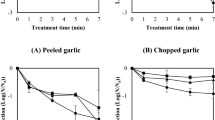Abstract
The efficacy of acidic electrolyzed water (AEW) for reducing total bacteria, coliforms, yeast and mold counts on commercial mung bean sprouts was investigated. The impact of pH, available chlorine concentration (ACC) and the cleaning method on antimicrobial efficacy of AEW was studied. AEW with a pH of 4.47 reduced the total bacterial, coliform, and yeast and mold counts on mung bean sprouts by 1.23, 1.42 and 1.25 log CFU/g, respectively. The efficacy of AEW increased with increasing ACC, and further studies showed that its antimicrobial ability was based on a combination of pH and ACC values. Cleaning using ultrasonic waves enhanced the antimicrobial activity of electrolyzed water, achieving reduction of 2.46, 2.13 and 2.92 log CFU/g for total bacterial, yeast and mold, and coliform counts, respectively. These results have indicated that using ultrasonic waves as a cleaning method, combined with AEW, could be a promising way to reduce the microbial populations on mung bean sprouts.




Similar content being viewed by others
References
Al-Haq MI, Sugiyama J, Isobe S (2005) Applications of electrolyzed water in agriculture and food industries. Food Sci Technol Res 11(2):135–150. doi:10.3136/fstr.11.135
Bari ML, Nazuka E, Sabina Y, Todoriki S, Ishiki K (2003) Chemical and irradiation treatments for killing Escherichia coli O157: H7 on alfalfa, radish, and mung bean seeds. J Food Prot 66(5):767–774
Bari ML, Enomoto K, Nei D, Kawamoto S (2011) Development of effective seed decontamination technology to inactivate pathogens on mung bean seeds and its practical application in Japan. Jpn Agric Res Q 45(2):153–161. doi:10.6090/jarq.45.153
Block SS (1983) Sterilants, disinfectants and antiseptics. In: Block SS (ed) Disinfection, sterilization, and preservation. Lea and Febiger, Philadelphia, pp 157–160
Ding T, Ge Z, Shi J, Xu YT, Jones CL, Liu DH (2015) Impact of slightly acidic electrolyzed water (SAEW) and ultrasound on microbial loads and quality of fresh fruits. LWT Food Sci Technol 60(2):1195–1199. doi:10.1016/j.lwt.2014.09.012
Hagger T, Morawicki R (2013) Potential for dry thermal treatments to eliminate foodborne pathogens on sprout seeds. Agric Food Anal Bacteriol 3(3):218–229
Hao JX, Liu HJ, Liu R, Dalai WY, Zhao RP, Chen TP, Li TL (2011) Efficacy of slightly acidic electrolyzed water (SAEW) for reducing microbial contamination on fresh-cut cilantro. J Food Saf 31(1):28–34. doi:10.1111/j.1745-4565.2010.00261.x
Huang YR, Hung YC, Hsu SY, Huang YW, Hwang DF (2008) Application of electrolyzed water in the food industry. Food Control 19(4):329–345. doi:10.1016/j.foodcont.2007.08.012
Koseki S, Itoh K (2000) The effect of available chlorine concentration of the disinfecting potential of acidic electrolyzed water for shredded vegetables. J Jpn Soc Food Sci Technol 47(12):888–898
Len SV, Hung YC, Erickson M, Kim C (2000) Ultraviolet spectrophotometric characterization and bactericidal properties of electrolyzed oxidizing water as influenced by amperage and pH. J Food Prot 63(11):1534–1537
Liu R, He X, Shi J, Nirasawa S, Tatsumi E, Li L, Liu HJ (2013) The effect of electrolyzed water on decontamination, germination and γ-aminobutyric acid accumulation of brown rice. Food Control 33(1):1–5. doi:10.1016/j.foodcont.2013.02.008
Liu R, Shi JQ, He XL, Nirasawa S, Tatsumi E, Liu HJ (2014) Effect of slightly acidic electrolyzed water on germination and sprouts growth of soybean seeds. Int Agric Eng J 23(3):50–56
Lu ZH, Zhang Y, Li LT, Curtis RB, Kong XL, Fulcher RG, Zhang G, Cao W (2010) Inhibition of microbial growth and enrichment of γ-aminobutyric acid during germination of brown rice by electrolyzed oxidizing water. J Food Prot 73(3):483–487
Ovissipour M, Al-Qadiri HM, Sablani SS, Govindan BN, Al-Alami N, Rasco B (2015) Efficacy of acidic and alkaline electrolyzed water for inactivating Escherichia coli O104: H4, Listeria monocytogenes, Campylobacter jejuni, Aeromonas hydrophila, and Vibrio parahaemolyticus in cell suspensions. Food Control 53:117–123. doi:10.1016/j.foodcont.2015.01.006
Rahman SME, Ding T, Oh DH (2010) Effectiveness of low concentration electrolyzed water to inactivate foodborne pathogens under different environmental conditions. Int J Food Microbiol 139(3):147–153. doi:10.1016/j.ijfoodmicro.2010.03.020
Rimhanen-Finne R, Niskanen T, Lienemann T et al (2011) A nationwide outbreak of Salmonella Bovismorbificans associated with sprouted alfalfa seeds in Finland, 2009. Zoonoses Public Health 58(8):589–596. doi:10.1111/j.1863-2378.2011.01408.x
Rui L, Jianxiong H, Haijie L, Lite L (2011) Application of electrolyzed functional water on producing mung bean sprouts. Food Control 22(8):1311–1315. doi:10.1016/j.foodcont.2011.02.005
Sharma RR, Demirci A, Beuchat LR, Fett WF (2003) Application of ozone for inactivation of Escherichia coli O157: H7 on inoculated alfalfa sprouts. J Food Process Preserv 27(1):51–64. doi:10.1111/j.1745-4549.2003.tb00500.x
Xiong K, Liu H, Li L (2012) Product identification and safety evaluation of aflatoxin B1 decontaminated by electrolyzed oxidizing water. J Agric Food Chem 60(38):9770–9778. doi:10.1021/jf303478y
Xiong K, Li X, Guo S, Li L, Liu H (2014) The antifungal mechanism of electrolyzed oxidizing water against Aspergillus flavus. Food Sci Biotechnol 23(2):661–669. doi:10.1007/s10068-014-0090-8
Yang H, Swem BL, Li Y (2003) The effect of pH on inactivation of pathogenic bacteria on fresh-cut lettuce by dipping treatment with electrolyzed water. J Food Sci 68(3):1013–1017. doi:10.1111/j.1365-2621.2003.tb08280.x
Yang H, Feirtag J, Diez-Gonzalez F (2013a) Sanitizing effectiveness of commercial “active water” technologies on Escherichia coli O157: H7, Salmonella enterica and Listeria monocytogenes. Food Control 33(1):232–238. doi:10.1016/j.foodcont.2013.03.007
Yang Y, Meier F, Ann Lo J et al (2013b) Overview of recent events in the microbiological safety of sprouts and new intervention technologies. Compr Rev Food Sci Food Saf 12(3):265–280. doi:10.1111/1541-4337.12010
Zhang C, Cao W, Hung YC, Li B (2016a) Disinfection effect of slightly acidic electrolyzed water on celery and cilantro. Food Control 69:147–152. doi:10.1016/j.foodcont.2016.04.039
Zhang C, Cao W, Hung YC, Li B (2016b) Application of electrolyzed oxidizing water in production of radish sprouts to reduce natural microbiota. Food Control 67:177–182. doi:10.1016/j.foodcont.2016.02.045
Acknowledgements
This work was supported by the Startup Project of Doctor Scientific Research of Yuncheng University (Grant No. YQ-2014026); the “131” Talents Funded Projects (Grant No. XK-2015019); and the Subject Cluster Project (Grant No. XK-2015010).
Author information
Authors and Affiliations
Corresponding author
Additional information
Rui Liu and Zhang-Long Yu contributed equally to this work.
Rights and permissions
About this article
Cite this article
Liu, R., Yu, ZL. Application of electrolyzed water on reducing the microbial populations on commercial mung bean sprouts. J Food Sci Technol 54, 995–1001 (2017). https://doi.org/10.1007/s13197-016-2445-z
Revised:
Accepted:
Published:
Issue Date:
DOI: https://doi.org/10.1007/s13197-016-2445-z




